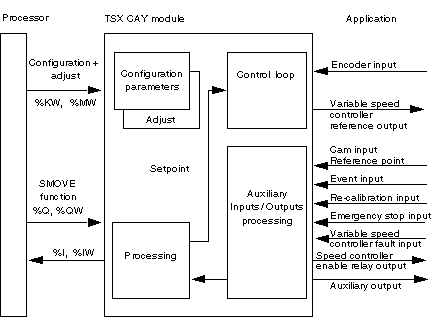The axis control modules provide application inputs and outputs for each of the axes, which are used to implement the different functions.
The following diagram shows the inputs/outputs associated with one channel:
Application Inputs/Outputs
For each of the axes, the axis control modules offer:
In inputs:
-
One input to acquire position measurements:
-
One input serving as a reference point cam (if an incremental encoder is selected).
-
One event input.
-
One emergency stop input.
-
One re-calibration on-the-fly input.
-
One drive fault input.
In outputs:
-
One 10 V analog output isolated from the logic part of the module. This 13 bit + sign resolution output is used to control a variable speed controller, associated with a continuous current motor, on autosynchronous or asynchronous auto-pilot.
-
A relay output to enable the variable speed controller.
-
A static auxiliary output.
In Control Expert language, each independent axis movement is described by a SMOVE movement command function. Movements of interpolated axes are described by an XMOVE command (linear interpolation of TSX CAY 33 module). From this SMOVE or XMOVE command and from the position of the moving part, module TSX CAY calculates the position/speed setpoint.
Configuration and Adjustment Parameters
These parameters are used to define the usage characteristics, limits, resolution, control dimensions, etc.
The loop controller is of proportional type with feed forward, so as to reduce following errors.
For each axis, the user can choose between 3 types of acceleration law: rectangular, trapezoid or triangular.
The functions offered by the axis control modules are as follows:
-
Position slave movement of another axis: one or more axes can be controlled by a master axis. The movements of the slave axis thus follow all the movements of the master axis.
-
Slave movement of a periodic setpoint: periodically, the position setpoint can be sent directly by the PLC processor.
-
Re-calibration on-the-fly: this function (used with an incremental encoder) is used to monitor the position of the moving part and to recalibrate the measurement when the re-calibration input is activated. This function can be used for movements with slip, so that the position measurement is periodically recalibrated.
-
Event processing: events detected by the module can be used to activate an event task in the sequential program.
-
Feed hold: this function is used to momentarily stop a movement in progress (e.g. to synchronize the axes).
-
Deferred pause: this function is used to momentarily stop a machine cycle without causing disturbance to it.
-
Step by step mode: this mode is used to carry out a sequence of movements stopping after each elementary instruction.
-
Movement monitoring: this function is used to detect any abnormal process operations (such as a faulty encoder), which do not change the position value even when the moving part moves.
-
Infinite axis function: (only available on the TSX CAY •2 modules), this function is used to process unlimited-type axes ("conveyor belt" applications). The axis defines a movement, which is always performed in the same direction.
It is also used for two other types of application:
-
Linear interpolation function: (only available on the TSX CAY 33 module). This function is used to associate 2 or 3 axes with the application-specific Interpolation function. It is used to access certain functional characteristics of numerical command machines.
NOTE: The 3 physical axes (X, Y, Z) use the zones 0, 1 and 2. Zone 3 is dedicated to the linear interpolation function.
Summary of TSX CAY Module Functions
The TSX CAY axis control modules perform the following functions:
|
Modules
|
CAY 21
|
CAY 41
|
CAY 22
|
CAY 42
|
CAY 33
|
|
2/3 axes interpolation
|
No
|
No
|
No
|
No
|
Yes
|
|
Limited axes
|
Yes
|
Yes
|
Yes
|
Yes
|
Yes
|
|
Infinite axes
|
No
|
No
|
Yes
|
Yes
|
Yes
|
|
Slave axes (static ratio)
|
Yes
|
Yes
|
No
|
No
|
No
|
|
Slave axes (dynamic ratio)
|
No
|
No
|
Yes
|
Yes
|
No
|
|
Integral gain (correction of offsets in the kinematic string)
|
No
|
No
|
Yes
|
Yes
|
Yes
|
